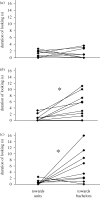Experimental evidence for limited vocal recognition in a wild primate: implications for the social complexity hypothesis
- PMID: 20462901
- PMCID: PMC2982026
- DOI: 10.1098/rspb.2010.0580
Experimental evidence for limited vocal recognition in a wild primate: implications for the social complexity hypothesis
Abstract
Although monitoring social information is a key aspect of the social complexity hypothesis, surprisingly little work has compared social knowledge across different species of wild animals. In the present study, I use playback experiments to test for individual recognition in wild male geladas (Theropithecus gelada) to compare with published accounts of social knowledge in chacma baboons (Papio ursinus). Geladas and baboons are closely related primates living in socially complex groups that differ dramatically in group size-geladas routinely associate with more than 10 times the number of conspecifics than do baboons. Using grunts from non-rival males to simulate approaches, I examined the strength of a subject male's response when the 'approach' was from the direction of (i) non-rival males (control), or (ii) rival males (a more salient stimulus if playback grunts are not recognized by the subject). I compared responses separately based on the degree of social overlap between the caller and the subject. Responses indicate that male geladas, unlike baboons, do not use vocalizations to recognize all of the individuals they regularly encounter. This represents, to my knowledge, the first documented evidence of 'missing' social knowledge in a natural primate population. The sharp distinction between baboons and geladas suggests that geladas are either unable or unmotivated to keep track of the individual identity of other males in their multi-level society-even males with whom they have a large degree of social overlap. Thus, these results are consistent with the central assumption of the social complexity hypothesis that social cognition is costly.
Figures



Similar articles
-
Derived vocalizations of geladas (Theropithecus gelada) and the evolution of vocal complexity in primates.Philos Trans R Soc Lond B Biol Sci. 2012 Jul 5;367(1597):1847-59. doi: 10.1098/rstb.2011.0218. Philos Trans R Soc Lond B Biol Sci. 2012. PMID: 22641823 Free PMC article.
-
Comparing responses to novel objects in wild baboons (Papio ursinus) and geladas (Theropithecus gelada).Anim Cogn. 2009 Jan;12(1):63-73. doi: 10.1007/s10071-008-0171-2. Epub 2008 Jun 24. Anim Cogn. 2009. PMID: 18574603
-
Inertia and Rapid Divergence in the Evolution of Yawning: A Comparison Between Two Closely Related but Socially Different Monkeys.Am J Primatol. 2025 Jun;87(6):e70049. doi: 10.1002/ajp.70049. Am J Primatol. 2025. PMID: 40437861 Free PMC article.
-
Theropithecus gelada distribution and variations related to taxonomy: history, challenges and implications for conservation.Primates. 2010 Oct;51(4):291-7. doi: 10.1007/s10329-010-0202-x. Epub 2010 May 28. Primates. 2010. PMID: 20509040 Review.
-
Bridging Captive and Wild Studies: Behavioral Plasticity and Social Complexity in Theropithecus gelada.Animals (Basel). 2021 Oct 19;11(10):3003. doi: 10.3390/ani11103003. Animals (Basel). 2021. PMID: 34680022 Free PMC article. Review.
Cited by
-
Social monitoring in a multilevel society: a playback study with male Guinea baboons.Behav Ecol Sociobiol. 2013 Jan;67(1):61-68. doi: 10.1007/s00265-012-1425-1. Epub 2012 Oct 11. Behav Ecol Sociobiol. 2013. PMID: 23293423 Free PMC article.
-
Human identity and the evolution of societies.Hum Nat. 2013 Sep;24(3):219-67. doi: 10.1007/s12110-013-9170-3. Hum Nat. 2013. PMID: 23813244
-
Wild geladas (Theropithecus gelada) in crops-more than in pasture areas-reduce aggression and affiliation.Primates. 2021 Jul;62(4):571-584. doi: 10.1007/s10329-021-00916-8. Epub 2021 Jun 1. Primates. 2021. PMID: 34061281 Free PMC article.
-
Individuality in coo calls of adult male golden snub-nosed monkeys (Rhinopithecus roxellana) living in a multilevel society.Anim Cogn. 2019 Jan;22(1):71-79. doi: 10.1007/s10071-018-1222-y. Epub 2018 Nov 20. Anim Cogn. 2019. PMID: 30460512 Free PMC article.
-
Vocal communication in a complex multi-level society: constrained acoustic structure and flexible call usage in Guinea baboons.Front Zool. 2013 Sep 23;10(1):58. doi: 10.1186/1742-9994-10-58. Front Zool. 2013. PMID: 24059742 Free PMC article.
References
-
- Aich H., Moos-Heilen R., Zimmermann E.1990Vocalizations of adult gelada baboons (Theropithecus gelada): acoustic structure and behavioural context. Folia Primatol. 55, 109–132 (doi:10.1159/000156508) - DOI - PubMed
-
- Barton R. A.1996Neocortex size and behavioral ecology in primates. Proc. R. Soc. Lond. B 263, 173–177 (doi:10.1098/rspb.1996.0028) - DOI - PubMed
-
- Bergman T. J., Beehner J. C.2003Hybrid zones and sexual selection: insights from the Awash baboon hybrid zone (Papio hamadryas anubis x P. h. hamadryas). In Sexual selection and reproductive competition in primates: new insights and directions, vol. 3 (ed. Jones C. B.), pp. 503–537 Norman, OK: American Society of Primatologists
-
- Bergman T. J., Beehner J. C., Cheney D. L., Seyfarth R. M.2003Hierarchical classification by rank and kinship in baboons. Science 302, 1234–1236 (doi:10.1126/science.1087513) - DOI - PubMed
-
- Bergman T. J., Beehner J. C., Cheney D. L., Seyfarth R. M.2006Interactions in male baboons: the importance of both males' testosterone. Behav. Ecol. Sociobiol. 59, 480–489 (doi:10.1007/s00265-005-0072-1) - DOI
Publication types
MeSH terms
LinkOut - more resources
Full Text Sources

